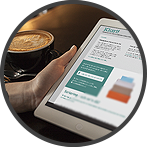Five ways to smoothly capture progress in a project
Datum: 2010-02-24 14:22

Do you find it hard to compile tasks that were completed in a project or an assignment with the purpose of writing a report or create an invoice from the hours you spend on the project?
Is the result of this that you work until late at night trying to finish the report in time or that you send the invoice much later than you would like to?
Could these difficulties be due to that it’s hard to remember what you did and for how long when trying to remember it long after it was completed?
Here are five simple tips on how to make this process easy as pie.
It’s always easiest to know exactly what you did and when you did it, so throughout these tips, you will learn how to consistently note completed and finished activities.
Notepad, Notes or some other note taking-software
Put a txt file (created in Windows’ Notepad, Mac’s TextEdit or the marvellous OmmWriter) in a folder on your desk in which you write a single line containing the date, what you did and possibly how long it took as soon as you have completed an activity. Let this txt file represent the current project.
When it’s time to compile and summarize what you did, open the txt file, read and then empty it of its contents, so that you always have an empty txt file when a new period begins.
An advantage with simple programs like these is that they can be opened quickly and that they don’t have any extra features which can be distracting.
Spreadsheet
Create a document in Excel or Numbers with one sheet containing the columns Date, Activity, Project, Time spent, possibly the rate, as well as the Month.
Write the recently completed activities in every row and let a formula calculate the total amount earned for each activity, using an hourly rate as a variable, if you are going to create an invoice from this information. Use the Pivot-chart feature to compile the total amount of hours worked, for instance, per project or month. After you are done compiling, hide the processed rows so that you always have a fresh chart to work with when a new period begins.
The advantage of using an excel sheet is that it’s easy to sort, calculate and summarize all your posts.
Web services
If you’re always connected to the internet when you’re working with your computer, a web service could be just the right thing for you. Basecamp from 37Signals is a popular choice and I also have business friends who speak warmly of Harvest. The latter service has a “widget”, which can “float” easily accessible on your desktop and in which you record how much time you spend on different project activities.
Both these services compile material for invoices more or less automatically.
Notes and boxes
If you prefer to work with physical sheets of paper, get yourself a notepad where you write down what you do when you do something. Get one suitably sized box per project or client and place them on your desk.
If you’re often on the move, get yourself a plastic case with several folders instead, and let each one of the folders represent a customer or a project. Once you’ve written down an activity on a note, put it in one of your client/project-boxes on your desk or in the right plastic folder. When it’s time to invoice or report, empty the box and compile all the activities. Get rid of the notes and start it all over again next month.
Time-reporting system
If you in your company use some sort of time reporting or task-management system, make sure it’s possible for you to register an activity instantly, either when you are doing it or right after you have completed it. If you can’t have the system opened on the computer all the time, use any of the other methods mentioned above. Enter the collected data into the system at suitable intervals.
Optional homework
If you want, think about what projects or clients you would be able to document at regular intervals and what method would suit you best.
How do you do it?
Do you have some other, smart way of capturing progress in a project? Tell me about it in a comment below.




